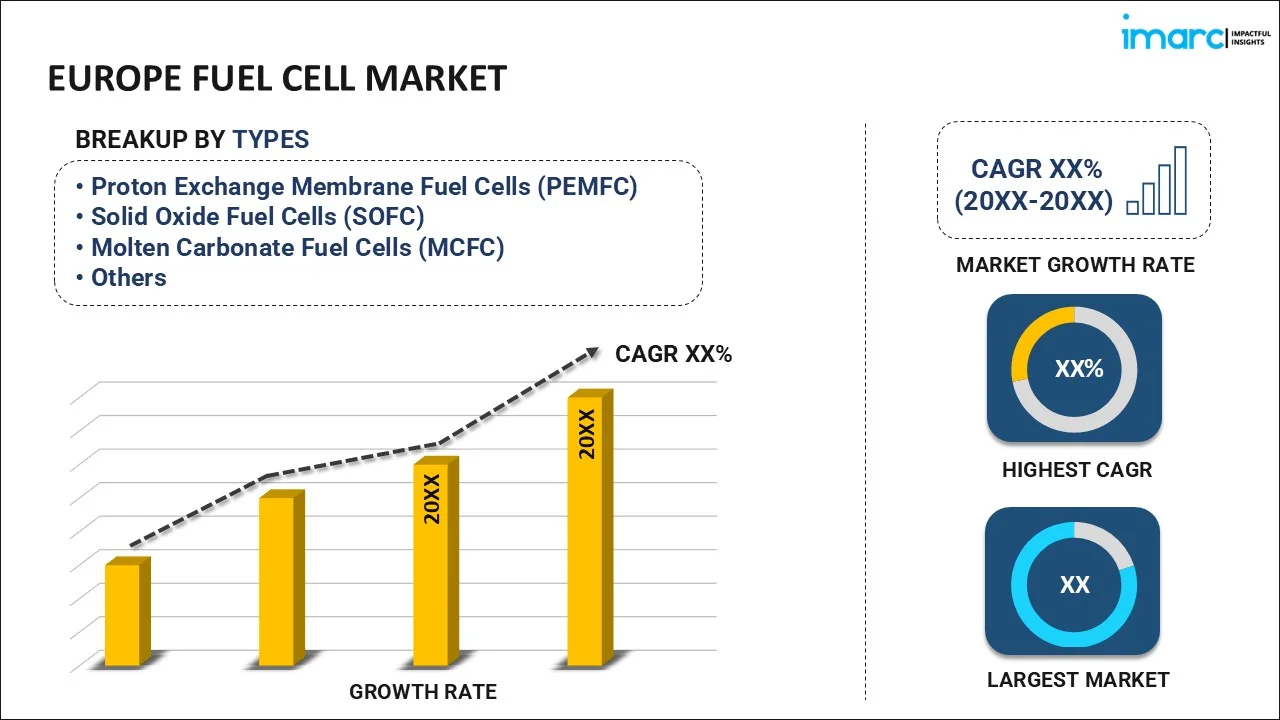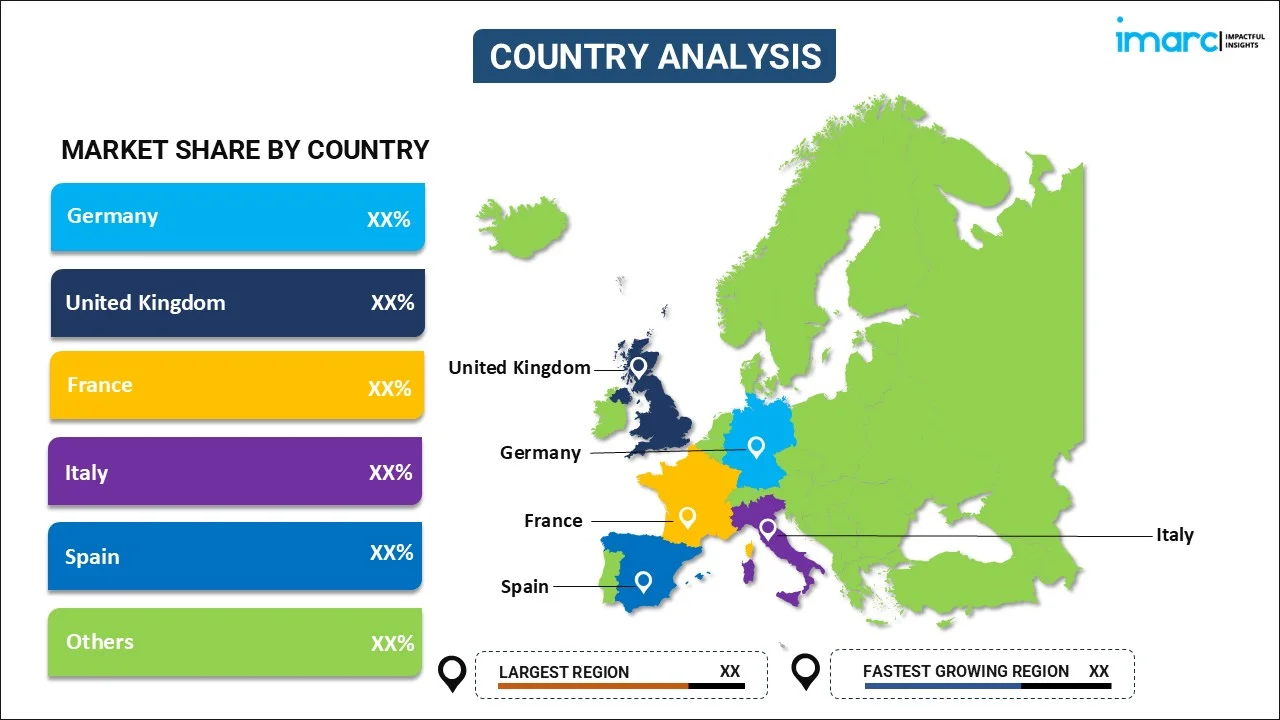
Europe Fuel Cell Market Size, Share, Trends, and Forecast by Type, Application, and Country, 2026-2034
Europe Fuel Cell Market Overview:
The Europe fuel cell market size reached USD 2,008.5 Million in 2025. Looking forward, IMARC Group expects the market to reach USD 10,251.4 Million by 2034, exhibiting a growth rate (CAGR) of 19.86% during 2026-2034. Stringent emission regulations, government incentives, rising hydrogen infrastructure, increased fuel cell vehicle adoption, decarbonization goals, advancements in solid oxide and PEM technologies, corporate sustainability initiatives, and demand for backup power in data centers and industrial applications are the factors propelling the growth of the market.
|
Report Attribute
|
Key Statistics
|
|---|---|
|
Base Year
|
2025 |
|
Forecast Years
|
2026-2034
|
|
Historical Years
|
2020-2025
|
| Market Size in 2025 | USD 2,008.5 Million |
| Market Forecast in 2034 | USD 10,251.4 Million |
| Market Growth Rate (2026-2034) | 19.86% |
Access the full market insights report Request Sample
Europe Fuel Cell Market Trends:
Rising Investments in Hydrogen-Powered Heavy-Duty Vehicles
Financial support for hydrogen fuel cell technology in commercial transportation is increasing throughout Europe. Governments and regional authorities are investing heavily in fuel cell truck research, production, and deployment. This program improves manufacturing capabilities, promotes widespread adoption, and strengthens the hydrogen supply chain. With large-scale projects scheduled to launch in the coming years, the transition to zero-emission heavy-duty transportation is gaining traction, boosting the effort for sustainable mobility and energy independence. For example, in November 2024, Germany's Federal Ministry for Digital and Transport, along with Baden-Württemberg and Rhineland-Palatinate, granted USD 236.36 Million for Daimler Truck via the EU's IPCEI Hydrogen initiative. The financing is toward the research, small-series production, and deployment of 100 fuel cell trucks. Production will take place at the Mercedes-Benz facility in Wörth, with customer operations beginning in late 2026. This project boosts Europe's fuel cell market and promotes hydrogen-powered heavy-duty vehicles.
Expansion of Hydrogen Fuel Cell Commercial Vehicles
The usage of hydrogen-powered commercial vehicles is increasing as production capacity expands. Larger fuel cell models are already joining mid-size options, offering additional flexibility and efficiency in logistics and freight operations. This initiative enhances the hydrogen vehicle sector, making zero-emission transportation more accessible to enterprises looking for sustainable solutions. The combination of longer range and faster refueling increases operational viability. This change is further supported by advancements in infrastructure and industrial processes. As the need for greener transportation options increases, hydrogen fuel cell cars are playing an important role in lowering emissions while keeping performance criteria. The growing popularity of these vehicles boosts efforts to decarbonize Europe's commercial transportation industry, which aligns with larger sustainability goals and legislative actions aimed at reducing emissions. For instance, in January 2024, Stellantis Pro One began its manufacturing of hydrogen fuel cell vehicles, adding larger versions to its current mid-size inventory. These vehicles have a range of 400-500 kilometers and require only 4-5 minutes to refill. The move enhances Europe's fuel cell sector and simplifies the transition to sustainable commercial transportation.
Europe Fuel Cell Market Segmentation:
IMARC Group provides an analysis of the key trends in each segment of the market, along with forecasts at the region/country level for 2026-2034. Our report has categorized the market based on type and application.
Type Insights:

To get detailed segment analysis of this market Request Sample
- Proton Exchange Membrane Fuel Cells (PEMFC)
- Solid Oxide Fuel Cells (SOFC)
- Molten Carbonate Fuel Cells (MCFC)
- Direct Methanol Fuel Cells (DMFC)
- Phosphoric Acid Fuel Cells (PAFC)
- Others
The report has provided a detailed breakup and analysis of the market based on the type. This includes proton exchange membrane fuel cells (PEMFC), solid oxide fuel cells (SOFC), molten carbonate fuel cells (MCFC), direct methanol fuel cells (DMFC), phosphoric acid fuel cells (PAFC), and others.
Application Insights:
- Stationary
- Transportation
- Portable
A detailed breakup and analysis of the market based on the application have also been provided in the report. This includes stationary, transportation, and portable.
Country Insights:

To get detailed regional analysis of this market Request Sample
- Germany
- France
- United Kingdom
- Italy
- Spain
- Others
The report has also provided a comprehensive analysis of all the major country markets, which include Germany, France, United Kingdom, Italy, Spain, and others.
Competitive Landscape:
The market research report has also provided a comprehensive analysis of the competitive landscape. Competitive analysis such as market structure, key player positioning, top winning strategies, competitive dashboard, and company evaluation quadrant has been covered in the report. Also, detailed profiles of all major companies have been provided.
Europe Fuel Cell Market News:
- In February 2024, Ricardo developed a high-powered and multi-stack hydrogen fuel cell module that generates 393kW of net electrical power in three months. The technology, developed as part of the Sustainable Hydrogen Powered Shipping (sHYpS) Horizon Europe project, has applications in marine, stationary electricity, rail, and off-highway. The modular architecture improves power density and scalability. Ricardo's virtual engineering toolchain accelerates development, lowers costs, and improves performance, therefore supporting Europe's transition to zero-emission energy solutions.
- In January 2025, cellcentric, a Daimler Truck-Volvo Group joint venture, acquired a 16-hectare site in Weilheim for its KLIMA|WERK factory, which would produce NextGen fuel cells for heavy-duty vehicles. Industrialization initiatives continue at the company's pilot facility in Esslingen. The action encourages Europe's shift to sustainable transportation by increasing fuel cell manufacturing for long-haul trucks, bolstering efforts to decarbonize the industry.
Europe Fuel Cell Market Report Coverage:
| Report Features | Details |
|---|---|
| Base Year of the Analysis | 2025 |
| Historical Period | 2020-2025 |
| Forecast Period | 2026-2034 |
| Units | Million USD |
| Scope of the Report | Exploration of Historical Trends and Market Outlook, Industry Catalysts and Challenges, Segment-Wise Historical and Future Market Assessment:
|
| Types Covered | Proton Exchange Membrane Fuel Cells (PEMFC), Solid Oxide Fuel Cells (SOFC), Molten Carbonate Fuel Cells (MCFC), Direct Methanol Fuel Cells (DMFC), Phosphoric Acid Fuel Cells (PAFC), and Others |
| Applications Covered | Stationary, Transportation, and Portable |
| Countries Covered | Germany, France, United Kingdom, Italy, Spain, and Others |
| Customization Scope | 10% Free Customization |
| Post-Sale Analyst Support | 10-12 Weeks |
| Delivery Format | PDF and Excel through Email (We can also provide the editable version of the report in PPT/Word format on special request) |
Key Questions Answered in This Report:
- How has the Europe fuel cell market performed so far and how will it perform in the coming years?
- What is the breakup of the Europe fuel cell market on the basis of type?
- What is the breakup of the Europe fuel cell market on the basis of application?
- What are the various stages in the value chain of the Europe fuel cell market?
- What are the key driving factors and challenges in the Europe fuel cell market?
- What is the structure of the Europe fuel cell market and who are the key players?
- What is the degree of competition in the Europe fuel cell market?
Key Benefits for Stakeholders:
- IMARC’s industry report offers a comprehensive quantitative analysis of various market segments, historical and current market trends, market forecasts, and dynamics of the Europe fuel cell market from 2020-2034.
- The research report provides the latest information on the market drivers, challenges, and opportunities in the Europe fuel cell market.
- Porter's Five Forces analysis assists stakeholders in assessing the impact of new entrants, competitive rivalry, supplier power, buyer power, and the threat of substitution. It helps stakeholders to analyze the level of competition within the Europe fuel cell industry and its attractiveness.
- Competitive landscape allows stakeholders to understand their competitive environment and provides an insight into the current positions of key players in the market.
Need more help?
- Speak to our experienced analysts for insights on the current market scenarios.
- Include additional segments and countries to customize the report as per your requirement.
- Gain an unparalleled competitive advantage in your domain by understanding how to utilize the report and positively impacting your operations and revenue.
- For further assistance, please connect with our analysts.
 Request Customization
Request Customization
 Speak to an Analyst
Speak to an Analyst
 Request Brochure
Request Brochure
 Inquire Before Buying
Inquire Before Buying




.webp)




.webp)












